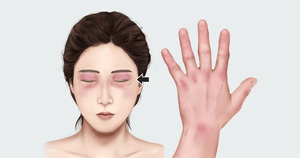Introduction to Dermatomyositis
Definition and Classification
Dermatomyositis (DM) is an autoimmune disease that affects skeletal muscle and skin, sometimes with heterogeneous systemic manifestations. It is one of the subgroups of the broader diagnoses of myositis, or otherwise known as idiopathic inflammatory myopathies. Patients with DM may present only with skin disease, muscle involvement, or have systemic involvement including the lungs, joints, heart, or gastrointestinal tract. Malignancy can also occur in close temporal association with dermatomyositis.
DM is classified as classic DM (CDM) or clinically amyopathic DM (CADM), distinguished by the presence or absence of clinical muscle weakness lasting ≥6 months, respectively. CADM can be differentiated from DM by absence of characteristic muscle weakness and muscle enzyme elevation. CADM comprises at least 20% of DM patients.
CADM is divided into amyopathic DM (ADM), with no evidence of clinical or laboratory muscle involvement, and hypomyopathic DM (HDM),…
To continue reading
Log in or register to continue reading. It's free!
OR
By signing up to create an account, I accept Healio's Terms of Use and Privacy Policy.
Definition and Classification
Dermatomyositis (DM) is an autoimmune disease that affects skeletal muscle and skin, sometimes with heterogeneous systemic manifestations. It is one of the subgroups of the broader diagnoses of myositis, or otherwise known as idiopathic inflammatory myopathies. Patients with DM may present only with skin disease, muscle involvement, or have systemic involvement including the lungs, joints, heart, or gastrointestinal tract. Malignancy can also occur in close temporal association with dermatomyositis.
DM is classified as classic DM (CDM) or clinically amyopathic DM (CADM), distinguished by the presence or absence of clinical muscle weakness lasting ≥6 months, respectively. CADM can be differentiated from DM by absence of characteristic muscle weakness and muscle enzyme elevation. CADM comprises at least 20% of DM patients.
CADM is divided into amyopathic DM (ADM), with no evidence of clinical or laboratory muscle involvement, and hypomyopathic DM (HDM), where subclinical muscle involvement is found following objective testing such as elevated muscle enzyme or muscle edema on muscle MRI. Patients with CADM can develop clinically evident myositis later in the disease course.
Myositis specific autoantibodies and associated antibodies are commonly seen in patients with dermatomyositis (Key Features of Dermatomyositis). These autoantibodies are tightly linked to the clinical expression of dermatomyositis and can be helpful in diagnosis and prognosis.
The cutaneous manifestations of DM can be chronic and debilitating especially in cases of severe skin ulcers. It often persists after successful treatment of muscle disease, and can greatly impact quality of life. Pruritus is a debilitating feature of DM that can negatively impact a person’s quality of life, alter sleep, and interfere with activities of daily living.
DM can impact both quality of life and life expectancy. Patients with DM have reduced quality of life, increased mortality, in particular with interstitial lung disease or cardiovascular involvement, and increased rates of malignancy.
References
- Aggarwal, R., Schessl, J., Charles-Schoeman, C. et al. Safety and tolerability of intravenous immunoglobulin in patients with active dermatomyositis: results from the randomised, placebo-controlled ProDERM study. Arthritis Res Ther 26, 27 (2024).
- ArgenX Press Release. Argenx Advances Clinical Development of Efgartigimod SC in Idiopathic Inflammatory Myopathies. November 20, 2024. https://argenx.com/content/dam/argenx-corp/newsroom/press-release-pdfs/PressRelease_argenx_ALKIVIA_Ph2_20241120.pdf.coredownload.inline.pdf



